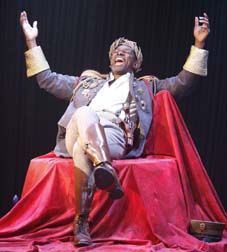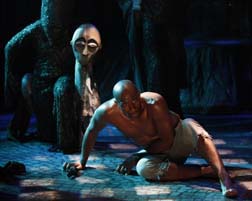Lucy Komisar
|
 |
| THE EMPEROR JONES" -- John Douglas Thompson, on his throne. Photo by Carol Rosegg. |
Director Ciaran O'Reilly has done a brilliant job in staging O'Neill's 1920 psychological thriller about the self-appointed emperor of a Caribbean backwater whose "subjects" suddenly turn on him. In this Irish Repertory Theatre production, John Douglas Thompson is overpowering as Brutus Jones, a black American who has fled from a southern chain gang and, persuading the locals that he can be killed only with a silver bullet, takes over in a "revolution" that removes the erstwhile chief.
Dressed as he assumes befits an emperor, Jones wears a blue coat with gold epaulets, jeweled pins, brown boots, and a crown of silver leaves. He speaks illiterate black English and exudes brutality. Figuring his tenure is limited, he squeezes his subjects with taxes and stashes the loot in foreign banks.
As crooked as Jones is Henry Smithers (Peter Cormican), a white British trader who helped the newcomer get his start and now sucks up to him.
O'Neill's Emperor may be an untaught chain gang escapee, but the author makes it clear that there's not a lot of difference between him and the big-time white crooks back home.
Brutus explains to Smithers, "Dere's little stealin' like you does, and dere's big stealin' like I does. For de little stealin' dey gits you in jail soon or late. For de big stealin' dey makes you Emperor and puts you in de Hall o' Fame when you croaks. (reminiscently) If dey's one thing I learns in ten years on de Pullman ca's listenin' to de white quality talk, it's dat same fact. And when I gits a chance to use it I winds up Emperor in two years."
 |
| John Douglas Thompson, in the forest. Photo byCarol Rosegg. |
But when Smithers reveals that the local blacks have disappeared from his "court" and are meeting to devise charms against the silver bullet, reality shifts. Brutus must make his escape through the forest to the coast, where he hopes to be picked up by a French gunboat that can take him to Martinique.
The trip through the forest tracks Jones's psychological disintegration as he progresses from arrogance to fear to terror and madness. His imagination transforms every shape and sound into a threat. In his stage direction, O'Neill writes, for example, "From the formless creatures on the ground in front of him comes a tiny gale of low mocking laughter like a rustling of leaves. They squirm upward toward him in twisted attitudes."
The forest of floating blue and green striped fabric tree trunks (by Charlie Corcoran) hide and reveal giant puppets and masked actors that haunt Jones with representations of his real and historical past. The puppets (by Bob Flanagan) embody one of Jones's victims as well as a chain gang overseer and convicts who wear striped pants and wield pick axes. The guard strikes Jones with a whip.
He is threatened by the crocodile god (Michael Akil Davis) and the terrifying beaked witch doctor (Sinclair Mitchell) who he fears will demand payment for his sins.
 |
| John Douglas Thompson, with puppet spirit. Photo by Carol Rosegg. |
His hallucinations take him back in race memory imagine whites – puppet-headed men squiring women puppets –attending a slave auction. And he is on the block. In hatred and fear, he demands, "Is dis a auction? Is you sellin' me like dey uster befo' de war? And you sells me? And you buys me?" He shoots his pistol at the visions of the auctioneer and the planter.
O'Reilly creates a surreal mood with the help of Flanagan's supernatural puppets and masks, Antonia Ford-Robert 's fantastical costumes, and eerie evocative music by Ryan Rumery and Christian Frederickson. The apparitions move to Barry McNabb dreamlike choreography.
But the soul of the production is Thompson's powerful, expressionistic and disturbing performance.
| lobby | search
| home | cue-to-cue |
discounts | welcome | film
| dance | reviews
|
| museums |
NYTW mail | recordings |
coupons | publications |
classified |

